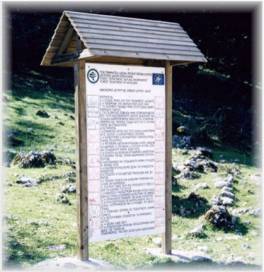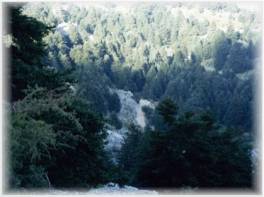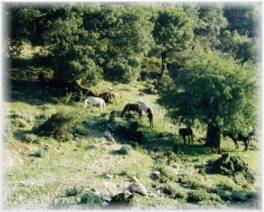|
NATIONAL PARK OF MOUNT AINOS | |
|
| |
|
Ainos
National Park was established in 1962, its core or central area is 2,862
hectares being the smallest of Greece's National parks. Situated between
to the towns of Argostoli and Sami. A tarmac road leads to the radar
station with the most spectacular views of the Omala Valley, the 40 wells
and the majestic Saint Yerasimos Monastery. From then on the road
deteriorates into an often dangerous and sometimes impassable track that
winds its way around the main mass, this then stretches as far down as the
slopes behind the hamlet of Arginia in the south of the island.
|
|
|
Please
take note - before entering -
the ingenious, multilingual cartoon style signs on the right hand board,
just inside the gates of the Park, especially note the warnings of fire
danger. As
more and more people became aware over the years of how the natural
environment was being used and abused with the landscape degraded and
destroyed for many reasons, in turn including the disappearance of native
species of flora and fauna. The Greek government began taking note of
their own natural heritage in 1937. By 1938 the first National Park was
designated on Mount Olympos. 'With
the aim of protecting the flora, the improvement and increase of the
fauna, the conservation of geomorphological formations and the protection
of natural beauty and development of tourism'. Regrettably
this was for mainland Greece only and not the islands. Even today after
all these years this still has not been the major priority of the National
Park of Kefalonia. | |
|
The
Park was established to protect the endemic Greek fir species, 'Abies cephalonica'
which
covers an area of 1,973 hectares, from crossbreeding. The dominion of
these tall elegant trees, was once much more extensive. Decimated by
forest fires during the 16th and 18th centuries, as well as being
relentlessly logged by the Venetians, who made masts from the trees for
their fleets of sailing galleys. |
|
|
Of
course there are other broad-leaved trees and bushes which groves among
the fir trees including arbutus and heathers, almonds, pear, thorns and
more. Over 646 hectares are covered in excellent shrub land, this is
mainly on the neighbouring part of the National Park, Mount Roudi, on the
northwestern mass of the Ainos mountain, which is crisscrossed with tracks
and pathways. However on the higher rocky and more alpine areas of Ainos,
there is a dominance of brushwood. | |
|
The
lower slopes of the National Park create a refuge for the endangered wild horses, species 'Equus
cabalus', who only
survive by feeding in a wider area than the park constitutes. This
mountainous landscape situated so close to the sea provides special
significance to the Park, which is full of rare flora. Unfortunately the
fauna of the Park is limited in terms of variety with only a few mammals
such as the red fox, hares and beech marten for instance. |
|
|
Albeit
a good number of bird species can be found rock partridge, short toed
eagle, owls, birds of prey as well as an array of songbirds, and of course
the pride of the island, the black woodpeckers, which do not appear on any
other Mediterranean island. During the winter months the mountain is
covered with a blanket of deep snow and often ice can still be found
completely blocking the roads in the spring and early summer. There are a
few picnic areas and gazebos, one with swings etc. for the children to
play. Its peak 'Megas Soros'
can only be reached on foot. Although their is a fire watch station with
some pleasing views for the less adventurous. This is situated next to the
monstrosities of aerials that have been allowed to be erected. However,
from the summit 1,628 metres you will have on a clear day one of the most
breathtaking views, for most, sights like this can only be experienced
from the dizzy heights of an aeroplane. | |
|
|
|


